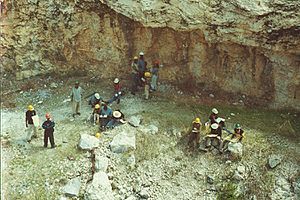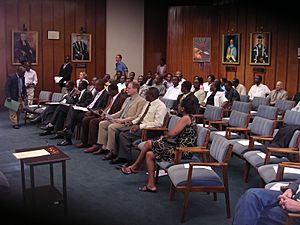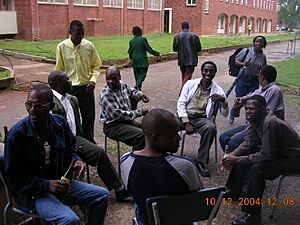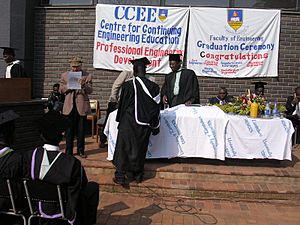University of Zimbabwe facts for kids
 |
|
|
Other name
|
UZ |
|---|---|
|
Former names
|
University College of Rhodesia and Nyasaland University College of Rhodesia University of Rhodesia University of Zimbabwe Rhodesia (1979) |
| Motto | Educating to Change Lives |
| Type | Public |
| Established | 1952 |
| Chancellor | Emmerson Mnagagwa (ex officio as President of Zimbabwe) |
| Vice-Chancellor | Paul Mapfumo |
|
Academic staff
|
140 professors, 545 lecturers, 155 teaching and research assistants (2018) |
| Undergraduates | 17,718 |
| Postgraduates | 2,681 |
| Location | , |
| Campus | Suburban |
The University of Zimbabwe (UZ) is a large public university located in Harare, Zimbabwe. It first opened its doors in 1952. Back then, it was known as the University College of Rhodesia and Nyasaland.
The university was connected with the University of London at first. Later, it changed its name to the University of Rhodesia. When Zimbabwe became an independent country in 1980, it got its current name. UZ is the oldest university in Zimbabwe.
Today, UZ has eleven different departments, called faculties. These faculties offer many types of degree programs. They also have special research centers. The university is officially recognized by the National Council for Higher Education. English is the main language used for teaching.
Contents
History
How the University Started
In 1945, a person named Manfred Hodson started the Rhodesia University Association. This group wanted to create a university. They were inspired by a promise of money from Robert Jeffrey Freeman.
The government of Southern Rhodesia agreed to create a university college in 1946. In 1947, a special fund was set up for it. The city of Salisbury (now Harare) offered land for the campus in 1948.
The first classes began in 1952 with about 68 students. They studied at a temporary location. Around the same time, a group led by Sir Alexander Carr-Saunders also suggested building a university college. They wanted it to serve the new Federation of Rhodesia and Nyasaland.
Building the University
Construction of the main campus began with money from the British Government and the Federation of Rhodesia and Nyasaland. Other groups also gave money. In July 1953, Queen Elizabeth The Queen Mother laid the first stone.
In 1955, the British Government officially recognized the school. It became the University College of Rhodesia and Nyasaland (UCRN). The college then joined with the University of London in 1956. All activities moved to the new campus in 1957.
Later, the college received more land for a farm and a research station. In 1963, the Medical School opened. It was connected to the University of Birmingham. After the Federation ended, the University College became an independent school. It welcomed students of all races. In 1970, its connections with the Universities of London and Birmingham began to end.
After Independence
After Zimbabwe became independent in 1980, the university was renamed the University of Zimbabwe. In 1981, Walter Kamba became the first black head of the university. In 1982, a new law replaced the old royal charter.
The number of students grew from 1,000 in 1980 to 2,000 by 1985. In 1998, the university hosted a big meeting for the World Council of Churches.
In 1989, many students protested the arrest of student leaders. Police came, and some students were hurt or arrested. The university then told all 8,000 students to leave the campus.
A law about the University of Zimbabwe was changed in 1990. Many people felt this change gave the government too much power. It also seemed to limit academic freedom. Student protests increased in the late 1980s and 1990s. This led to the university closing several times and many students being expelled.
Despite these challenges, the university continued to grow. By 1995, there were 8,000 students, and by 2001, there were over 10,000. In the 2000s, the university had trouble paying its teachers enough. This caused many strikes. Some countries, like Sweden, stopped giving money to UZ.
As Zimbabwe's economy faced problems, UZ struggled to find enough teachers. By 2007, there weren't enough staff to teach some courses. Problems with water, electricity, and building upkeep also became serious. The university even failed to open for the 2008–2009 school year. It opened briefly in 2009, but classes stopped due to teacher strikes. It closed again in February after students protested new fees.
Degree Concerns
The university faced questions about a degree given to Grace Mugabe in 2014. She received a doctorate in sociology just two months after starting the program. Her research paper was not found in the university's records.
On November 20, 2017, University of Zimbabwe students refused to take their exams. They demanded that Grace Mugabe's degree be taken back. They also protested and said they would not take exams until Robert Mugabe resigned. The president resigned the next day. Many people believe the students helped bring about the end of his 37-year rule.
Campus
The main campus of the University of Zimbabwe is in the Mount Pleasant area of northern Harare. The campus is very large, covering about 299 hectares (739 acres). It is part of a special area set aside for education.
There are 171 buildings on the main campus. These include classrooms, student dorms, and staff housing. The campus also has sports fields and a large grassy area called the College Green. This is a popular spot for social events. About one-third of the campus is a wetland area that cannot be built on.
UZ also has facilities in other parts of Zimbabwe. In Harare, it has 46 buildings outside the main campus. The university's main satellite campus is at the Parirenyatwa Hospital. This is where the College of Health Sciences is located.
Other university properties in Harare include apartments for staff and students. Outside Harare, UZ has facilities in Bulawayo, Kariba, and Teviotdale. The university runs the University of Zimbabwe Lake Kariba Research Station in Kariba. It also has the University of Zimbabwe Farm, which is used for teaching and research in agriculture.
Several of Zimbabwe's newer universities started as colleges of UZ. These include Bindura University of Science Education, Chinhoyi University of Technology, and Zimbabwe Open University.
Academics
Undergraduate Studies

For undergraduate students at UZ, learning mainly happens through lectures. These are given by professors or lecturers. Smaller group discussions, called tutorials, are led by lecturers or teaching assistants. Many programs also include hands-on work in labs or field trips.
Students are graded on tests and assignments. Practical work also gets a grade. There are also final exams.
The degree programs use a "Course Unit" system. This means students can often choose some of their courses. For Honours degrees, students must complete a special project on their own.
UZ offers different types of undergraduate degrees. These include Bachelor's degrees and Bachelor (Honours) degrees. Some popular subjects include arts, business studies, computer science, education, law, science, and medicine.
Postgraduate Studies

The University of Zimbabwe also offers advanced degrees for students who want to study more. These are called postgraduate degrees. They include postgraduate honours degrees, master's degrees, and doctoral degrees.
Postgraduate honours programs usually last one year. They involve coursework, exams, and a required project. Master's degrees can take one to two years. They include coursework and projects or can be based only on a research paper. Doctoral degrees, called D.Phil., are based only on a research paper and take at least two years.
Program Changes
In the 2000s, UZ had fewer teachers. Because of this, some programs and special courses had to be paused.
University Rankings
The University of Zimbabwe is considered a top university in Zimbabwe. In 2007, it was ranked 14th in Africa by the World Universities Ranking. By 2010, it was ranked as the best university in Zimbabwe by University Ranking by Academic Performance (URAP).
Administration and Organisation
How UZ is Run
The main leader of the university is the Chancellor. This role is held by the President of Zimbabwe. The university is managed by a group called the University Council. This council includes university leaders, teachers, students, and people from businesses and the community.
The main person in charge of the university's daily operations is the Vice-Chancellor. This person is chosen by the Chancellor. The Vice-Chancellor gets help from other leaders called Pro–Vice-Chancellors.
The academic decisions of the university are made by the Senate. This group includes university leaders, heads of departments, professors, and student representatives. The university is divided into different departments called faculties. Each faculty has a dean and a board that manages its programs.
Faculties
The University of Zimbabwe has twelve academic faculties:
| Faculty | Departments | Institutes | Centres |
|---|---|---|---|
| Agriculture Environment And Food Systems | Agricultural Economics and Extension Animal Science Crop Science Soil Science and Agricultural Engineering |
||
| Arts And Humanities | African languages and Literature English Economic History History Linguistics Modern Languages Religious Studies, Classics and Philosophy Theatre arts |
African languages research institute Confucius Institute |
Communication Skills Centre Centre for Defence Studies |
| Medicine and Health Sciences | Medical Laboratory Sciences
Surgery |
Institute of Continuing Health Education | |
| Business Management Sciences and Economics | Accountancy Business Studies Tourism, Leisure and Hospitality Studies |
||
| Computer Engineering Informatics and Communications | Analytics and Informatics
Computer Engineering Electronics and telecommunications Computer Technology Training Development |
||
| Education | Adult Education Curriculum and Arts Education Educational Administration |
Human Resources Research Centre | |
| Engineering and Built Environment | Civil Engineering Electrical Engineering Geoinformatics and Surveying Mechanical Engineering Metallurgy Mining Engineering |
Centre for Continuing Engineering Education | |
| Law | Constitutional law Private law Procedural law Public law |
Commercial law Institute Women's Law Institute of Southern Africa |
|
| Science | Biological Sciences Biochemistry Chemistry Computer Science Food, Nutrition and Family Sciences Geology Mathematics Physics Electronics and Telecommunication Technology |
Institute of Mining Research | Mineral Resources Centre |
| Social and Behavioural Sciences | Economics Political and Administrative Studies< Psychology Rural and Urban Planning Sociology |
Centre for Applied Social Studies Centre for Population Studies |
|
| Veterinary Science | Preclinical Veterinary Science Clinical Veterinary Science Paraclinical Veterinary Science |
Former Colleges
The university used to have one college, the College of Health Sciences. It is now called the Faculty of Medicine and Health Sciences. Many of Zimbabwe's public universities actually started as colleges of the University of Zimbabwe:
| Former college of the University of Zimbabwe | Current University |
|---|---|
| Bindura University College for Science Education | Bindura University of Science Education |
| Chinhoyi University College | Chinhoyi University of Technology |
| University College of Distance Education | Zimbabwe Open University |
Research Institutes
The university has two special research institutes. These are the Institute of Development Studies (IDS) and the Institute of Environmental Studies (IES). They focus on different areas of research.
Partner Institutions
Many other schools are connected to the University of Zimbabwe. These include colleges that train teachers and the School of Social Work.
School Year
The academic year at UZ usually runs from August to June. Graduation ceremonies are typically held in September. Since February 2016, the university also has a second start date for students. This academic year runs from February to December.
Student Life
Where Students Live
On the main campus, there are several places for students to live. There are five dorms for women and four for men. There is also a Medical Residence at the Medical School campus. Another residence is in central Harare. The dorms were closed for a while in 2007 for repairs but reopened in 2014.
Sports, Clubs, and Traditions
The university wants at least one student or former student to represent Zimbabwe in sports each year. Sports at UZ are centered around the Sports Pavilion. This building was a gift from National Breweries.
Students can play many sports, including athletics, basketball, cricket, football, field hockey, rugby, and tennis. UZ often wins the Zimbabwe Universities Sports Association Games.
The University of Zimbabwe Football Club plays in Zimbabwe's Division two. Famous football player Benjani Mwaruwari used to play for this club. The club was even coached by former President Canaan Banana for a time. When Zimbabwe hosted the All-Africa Games in 1995, UZ was the main village for the athletes.
Other popular sports at UZ include Basketball, Volleyball, Rugby, and Handball. These teams play in professional leagues in Harare. In October 2015, the Sports Department started a Handball festival. This event celebrates the university's anniversary and happens every year.
Most departments have clubs related to their subjects. There are also non-academic clubs like Rotaract. In 2005, UZ won the Students in Free Enterprise World Cup in Canada.
Supporting All Students
The university works to ensure all students have equal opportunities. In 1995, a program was put in place to help more female students enroll. The university aims to create a safe and supportive environment for everyone.
Notable People
Leaders of the University
The first head of the university was William Rollo. He was the temporary Principal from 1953 to 1955. The first official Principal was Walter Adams, who served from 1955 to 1966.
Later leaders included Terence Miller and Robert Craig. Leonard J. Lewis led the university during Zimbabwe's independence. In 1981, Walter Kamba became the first Vice-Chancellor. He was followed by Gordon Chavunduka and then Graham Hill.
Levi Nyagura was the longest-serving Vice-Chancellor, from 2003 to 2018. He was suspended due to questions about a doctoral degree awarded to former First Lady Grace Mugabe. In August 2018, Professor Paul Mapfumo became the acting Vice-Chancellor. He was officially appointed in June 2019.
Teachers and Alumni
Many important people have taught at or graduated from the University of Zimbabwe. You can find more information about them in these lists:
- List of University of Zimbabwe people#Faculty
- List of University of Zimbabwe people#Alumni
See also
 In Spanish: Universidad de Zimbabue para niños
In Spanish: Universidad de Zimbabue para niños




